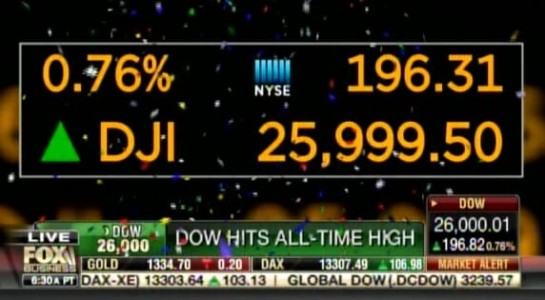
Market Conspiracy
Three new recently published scientific papers seem to confirm what many have claimed for years: the “efficient markets” are not only inefficient – from an informational standpoint – they are also badly rigged. Of the three papers, the Economist reports, one argues that well-connected insiders profited even from the financial crisis, while the other two go so far as suggesting the entire share-trading system is rigged.
Unlike conventional insider trading cases – which traditionally require fortuitous tip-offs and extensive, expensive investigations, involving the examination of complex evidence from phone calls, e-mails or informants wired with recorders – the papers make imaginative use of pattern analysis from data to find that insider trading is probably pervasive, according to the Economist.
The approach reflects a new way of analyzing conduct in the financial markets. It also raises questions about how to treat behaviour if it is systemic rather than limited to the occasional rogue trader.
The first paper starts from the private meetings American government officials held during the crisis with financial institutions. As discussed here years ago, what was not made public at the time were critical details about the infamous TARP program (which incidentally was created and administrated by current Minneapolis Fed president Neel Kashkari who paradoxically rages every day against bailouts of Too Big To Fail banks), notably how much money would be involved and how it would be allocated. This mattered hugely as the very survival of some institutions was at stake; in the end, hundreds of billions of dollars were pledged. Knowing the structure and scope of the bail-out in advance would have been a vitally important piece of information for investors during this period.
The paper examines conduct at 497 financial institutions between 2005 and 2011, paying particular attention to individuals who had previously worked in the federal government, in institutions including the Federal Reserve. In the two years prior to the TARP, these people’s trading gave no evidence of unusual insight. But in the nine months after the TARP was announced, they achieved particularly good results. The paper concludes that “politically connected insiders had a significant information advantage during the crisis and traded to exploit this advantage.”
Almost as if the Fed was working covertly with Wall Street to make insiders richer, at the expense of the middle class…
The other papers use data from 1999 to 2014 from Abel Noser – a firm used by institutional investors to track trading transaction costs – which covered 300 brokers, and focused on the 30 biggest, through which 80-85% of the trading volume flowed.
“They authors found evidence that large investors tend to trade more in periods ahead of important announcements, say, which is hard to explain unless they have access to unusually good information.”
The brokers could acquire such information in several ways, of which the most innocent was that brokers “spread the news” of a particular client’s desire to buy or sell large amounts of shares in order to create a market, much as an auction house might do for a painting. But – it is also possible, the papers suggest – and is much more likely that banks give this information to favoured clients to boost their own business. Strengthening this argument is the finding that large asset managers which use their own affiliated brokers do not lose out.
As The Economist summarizes, “as a result of the findings, large institutions can be both beneficiaries and victims of this sort of information leakage. But in general they are net gainers. The real losers, the papers conclude, are retail customers and smaller asset managers.” And, of course, the broader investing public.
As for the punchline:
“Common to all the papers is the recognition that the public markets are, as conspiracy theorists have long argued, not truly public at all” and that “changing the law to fix that may not even be feasible.”
Which one can almost say is ironic, coming from a publication which is 26% owned by the Rothschild family.
* * *
The papers in question are:
“Political connections and the informativeness of insider trades” by Alan D. Jagolinzer, Judge Business School, University of Cambridge; David F. Larcker, Graduate School of Business, Rock Center for Corporate Governance, Stanford University; Gaizka Ormazabal, IESE Business School, University of Navarra; Daniel J. Taylor, the Wharton School, University of Pennsylvania. Rock Center for Corporate Governance at Stanford University, Working Paper No. 222.
“Brokers and order flow leakage: evidence from fire sales” by Andrea Barbon, Marco Di Maggio, Francesco Franzoni, Augustin Landler. National Bureau of Economist Research, Working Paper 24089, December, 2017
“The Relevance of Broker Networks for Information Diffusion in the Stock Market” by Marco Di Maggio, Francesco Franzoni, Amir Kermani and Carlo Summavilla. NBER Working Paper, No 23522, June, 2017.
Source: Zero Hedge
